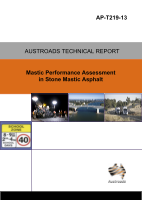Pavement

- Publication no: AP-T219-13
- ISBN: 978-1-921991-66-0
- Published: 16 January 2013
- PDF (free) Download
The primary focus of this study was to assess the stiffening effect of different filler types while using different bituminous binders. The significant influence of filler in the mastic of asphalt mixtures is well known and the effect is more profound in stone mastic asphalt (SMA).
The selection of the filler was based on general availability and the representative Rigden voids (RV), at low, medium and high ranges. Fine ground limestone (FGLS), baghouse dust (BD), fly ash (FA) and one combined filler (BD+FA) were blended with Class C320, A20E, A15E and A35P binders at different filler/binder (F/B) ratios. Using Monte Carlo simulation, a sensitivity analysis was performed to gain a better understanding of the limitations of the F/B ratios using different fillers.
The Brookfield viscosity test was performed at 135 °C and 165 °C in order to assess the mastic properties at production and compaction temperatures. These results were analysed using assumed viscosity limits for production and compaction. For a relative comparison of in-service behaviour, the dynamic shear rheometer (DSR) test was performed at five different temperature levels from 50 °C to 70 °C, and 15 different frequency values. The complex modulus (G*) obtained from the DSR experiment was analysed, producing summary statistics and a model for the modulus of various mastic types under varying conditions. A flow chart was developed for the process of the mastic assessment and it was emphasised that the material selection has a great impact on the workability and the overall performance. In the flow chart the temperature effect of the climatic regions and speed applications are also taken into account.
The delta ring and ball (=R&B) test, a simple test method, was introduced for the assessment of the stiffening effect of mineral fillers used in asphalt materials according to the European Standard.
The study provided practical considerations for selecting an appropriate filler/binder combination for SMA applications and it is envisaged that the findings of this investigation could also be applied to the stiffening potential of filler/binder combinations in other types of asphalt. However, the report does not discuss other applications.
- 1. INTRODUCTION
- 1.1. Filler Types Used in Asphalt Mixes
- 1.1.1. Fine Ground Limestone
- 1.1.2. Fly Ash
- 1.1.3. Hydrated Lime
- 1.1.4. Baghouse Fines from Asphalt Plants
- 1.2. Stiffening Effect of Fillers
- 1.2.1. Which Factors Influence the Filler/Binder Ratio and the Mastic Properties
- 1.2.2. Impact of the Stiffening Effect on Asphalt Compaction
- 1.2.3. Thermal Cracking Due to Stiff Asphalt Material
- 1.2.4. The Use of Filler/Binder Ratio
- 1.2.5. US Study on Field Validation of SMA Performance
- 2. Laboratory assessment of the mastic ingredients
- 2.1. Test Procedures for Filler
- 2.1.1. Apparent Particle Density Measurement
- 2.1.2. Rigden Voids
- 2.1.3. Particle Size Distribution (PSD)
- 2.2. Test Procedures for the Binder
- 2.2.1. Test Procedures for Bitumen
- 2.2.2. Test Procedures for PMBs
- 3. Preliminary testing and analysis
- 3.1. Preliminary Testing of the Mastic
- 3.1.1. Mastic Preparation and Workability
- 3.1.2. Preliminary Brookfield Test Results
- 3.1.3. Preliminary DSR Test – Strain Sweep Test
- 3.2. Identifying F/B Ratios for the Main Test Series
- 3.2.1. Practical Limits of the F/B Ratio
- 3.2.2. Sensitivity Analysis – Possible F/B Ratios
- 3.2.3. Selected F/B Ratios for the Main Test Series
- 3.2.4. The Range of Fixed Binder Fraction Value (Fb) and the Free Binder Volume (Vf) of the Tested Mastic Samples
- 4. Main test series
- 4.1. Mastic Preparation
- 4.2. Main Test Series – Brookfield Test
- 4.3. Main Test Series – DSR Test
- 5. Analysis and evaluation of the Brookfield test results – handling temperatures
- 5.1. Brookfield Test Results, Determination of Binder Viscosity Ranges for Mixing and Compaction
- 5.1.1. Binder Only
- 5.1.2. Mastics
- 5.1.3. Modified Binders
- 5.1.4. Maximum Suggested Production Temperatures According to AAPA Advisory Note 7
- 5.2. Analysis of the Mastic Viscosity at Handling Temperature
- Mixing
- Compaction
- 6. Analysis and evaluation of the DSR test results – in-service temperatures
- 6.1. Statistical Analysis of the DSR Test Results
- 6.1.1. The DSR Data
- 6.1.2. Data Analysis
- 6.1.3. Modelling
- 6.2. Temperatures for In-service Situations
- 6.3. Frequency–speed Conversion
- 7. Measuring the stiffening effect of fillers using the softening point test (delta ring and ball test) and the fineness test
- 7.1. Delta Ring and Ball Test According to EN 13179-1
- 7.1.1. Specification Limits
- 7.1.2. Preparation of the Mastic
- 7.1.3. Softening Point Test
- 7.2. Test Results of the Delta Ring and Ball Test (ï„R&B)
- 7.3. Test Results of the Fineness Test
- 7.4. Analysis of Softening Point Change against Rigden Voids and Fineness
- ï„R&B versus Rigden voids (Vol %) and fineness (percentage passing 45 micron sieve (%)):
- 8. Summary and Conclusions
- 8.1. Performance Assessment of the Mastic in the SMA Mix
- 8.2. Practical Considerations and Conclusions
- 8.2.1. Summary of Past Investigation for the Improvement of SMA Design, Production and Placement
- 8.2.2. Filler Material Used in SMA
- 8.2.3. Fibre Additives and Drain-off
- 8.2.4. Hydrated Lime as Anti-stripping Agent in SMA
- 8.2.5. Utilisation of the Outcomes of the Test Series and Analysis for Other Asphalt Types
- References
- Appendix A Particle size distribution
- Appendix B Brookfield viscosity test results
- Appendix C Weights used for mastic production
- Appendix D Viscosity and torque reading for the main Brookfield test series
- Appendix E DSR test results
- Appendix F Brookfield viscosity results – extrapolation
- Appendix G Analysis of variance for the final overall model–DSR test
